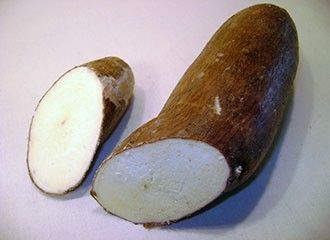The yuca, a starchy tuberous root called also manioc, not to be confused with the yucca, is native to South America und was a staple food for many pre-Columbian cultures in Peru. The cassava, as yuca is known in English, was often depicted in indigenous art, like on Moche ceramics.
The yuca root is long and tapered. On the outside of yucas is a rough and brown rind. The flesh can be white or yellowish.
Never ever consume yuca raw. It contains cyanide and therefore must be cooked properly to detoxify it before it is eaten. This also applies to the sweeter Yucas that contain fewer toxins than the bitter ones.
The properly prepared and boiled roots have a tasty flavor and can replace potatoes in many dishes. They are served with meat dishes, made into purées and dumplings or used in soups and stews.
Deep fried yuca (after boiling or steaming) is delicious and served either as replacement for fries or with typical Peruvian salsas.



























